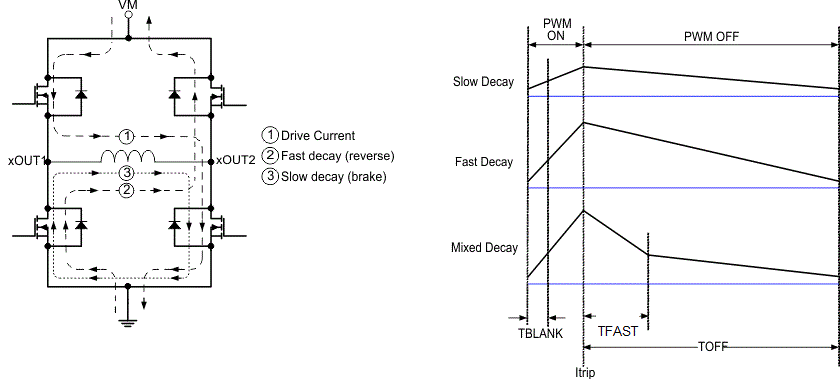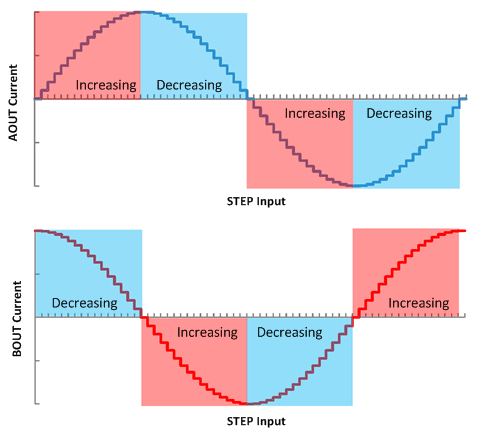ZHCSND1A November 2020 – May 2022 DRV8434
PRODUCTION DATA
- 1 特性
- 2 应用
- 3 说明
- 4 Revision History
- 5 Pin Configuration and Functions
- 6 规格
- 7 详细说明
- 8 Application and Implementation
- 9 Power Supply Recommendations
- 10Layout
- 11Device and Documentation Support
- 12Mechanical, Packaging, and Orderable Information
封装选项
机械数据 (封装 | 引脚)
散热焊盘机械数据 (封装 | 引脚)
- RGE|24
订购信息
7.3.6 Decay Modes
During PWM current chopping, the H-bridge is enabled to drive through the motor winding until the PWM current chopping threshold is reached. This is shown in Figure 7-6, Item 1.
Once the chopping current threshold is reached, the H-bridge can operate in two different states, fast decay or slow decay. In fast decay mode, once the PWM chopping current level has been reached, the H-bridge reverses state to allow winding current to flow in a reverse direction. Fast decay mode is shown in Figure 7-6, item 2. In slow decay mode, winding current is re-circulated by enabling both of the low-side FETs in the bridge. This is shown in Figure 7-6, Item 3.
 Figure 7-6 Decay Modes
Figure 7-6 Decay ModesThe decay mode of the DRV8434 is selected by the DECAY0 and DECAY1 pins as shown in Table 7-6. If DECAY1 pin is Hi-Z, irrespective of the DECAY0 pin voltage, the decay mode will be smart tune dynamic decay. The decay modes can be changed on the fly. After a decay mode change, the new decay mode is applied after a 10 µs de-glitch time.
| DECAY0 | DECAY1 | INCREASING STEPS | DECREASING STEPS |
|---|---|---|---|
| 0 | 0 | Smart tune Dynamic Decay | Smart tune Dynamic Decay |
| 0 | 1 | Smart tune Ripple Control | Smart tune Ripple Control |
| 1 | 0 | Mixed decay: 30% fast | Mixed decay: 30% fast |
| 1 | 1 | Slow decay | Mixed decay: 30% fast |
| Hi-Z | 0 | Mixed decay: 60% fast | Mixed decay: 60% fast |
| Hi-Z | 1 | Slow decay | Slow decay |
Figure 7-7 defines increasing and decreasing current. For the slow-mixed decay mode, the decay mode is set as slow during increasing current steps and mixed decay during decreasing current steps. In full step and noncircular 1/2-step operation, the decay mode corresponding to decreasing steps is always used.
 Figure 7-7 Definition of Increasing and Decreasing Steps
Figure 7-7 Definition of Increasing and Decreasing Steps